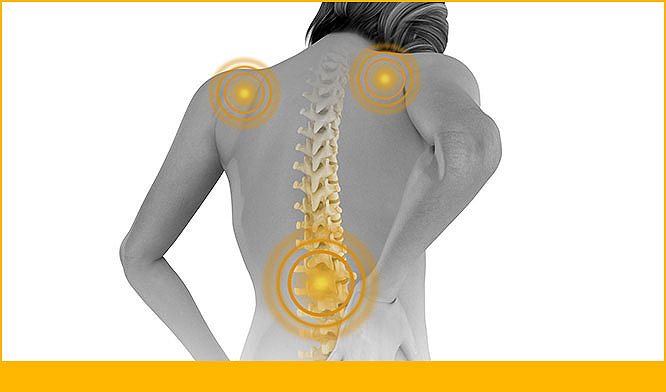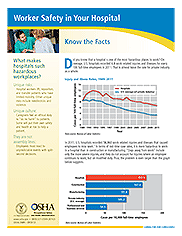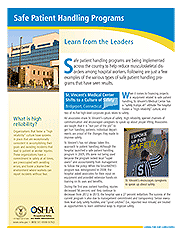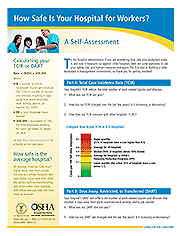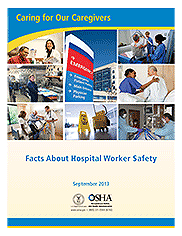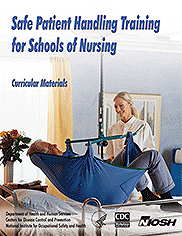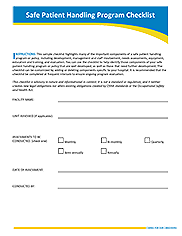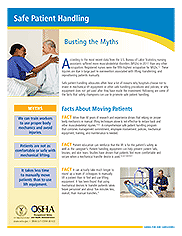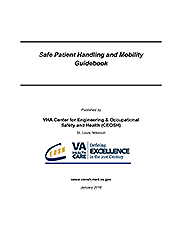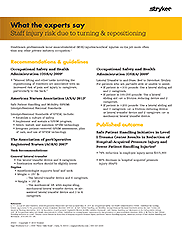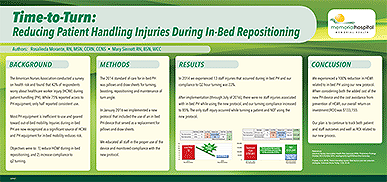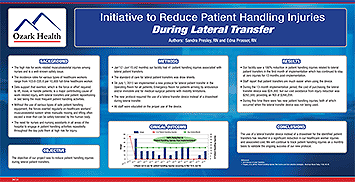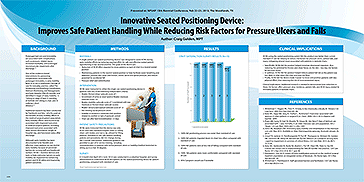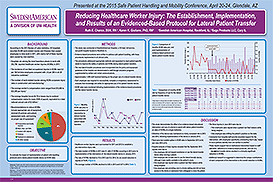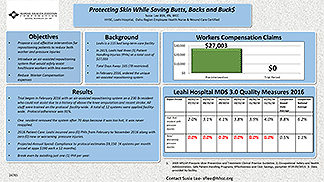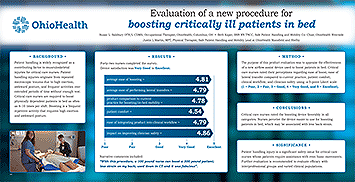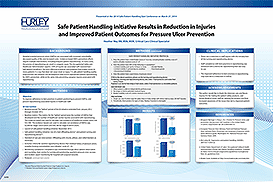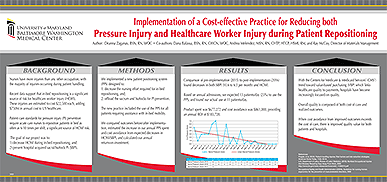Caregiver safety
Now more than ever, we need to protect our healthcare staff. The tasks that caregivers must complete often puts their safety in jeopardy. In this section, you will find a variety of courses and resources to create awareness of the everyday patient care activities that pur caregivers at risk and educate our healthcare staff on nationally recognized standards for safe patient handling and mobility.
O.R. Safety Webinar Series: Protecting Caregivers
Topic 1: Safe Patient Handling in the O.R.
- Define Safe Patient Handling
- Review the biomechanics of lifting
- Describe the impact of lifting on caregivers and patients
- Recognize high risk patient care activities
- Identify components of SPH program
Topic 2: Fluid Waste Management
- Describe the different types of medical errors in the O.R.
- Define the types of medical waste and how the O.R. is specifically impacted
- List the current practices and potential hazards associated with liquid waste
- Describe the risks associated with fluid waste management in the O.R.
- List the benefits of an effective and safe fluid waste management program in the O.R.
Safe Patient Handling
Learning objectives
- Provide the fundamental information related to the epidemiology of healthcare worker injury
- Review the biomechanics involved in patient care tasks
- Outline the physiology of injury to caregivers
- Identify the high-risk tasks involved in patient care
Understanding Obesity
Learning objectives
- Define obesity and patient demographics
- Discuss healthcare and human costs associated with obesity and patient comorbidities
- Evaluate clinical considerations to assist in providing appropriate care for patients who are obese
- Identify specialize equipment and evaluate strategies and recommendations in caring for patients with obesity
Continuous quality improvement sustainability
Learning objectives
- Describe the definition of sustainability in continuous quality improvement
- Describe four barriers to sustaining a change or intervention
- Identify three key components for sustaining change in the clinical setting
OSHA: Know the Facts
What makes hospitals such hazardous workplaces?
- Unique risks
- Unique culture
- They are not assembly lines
OSHA: Learn from the Leaders
Safe patient handling programs are being implemented across the country to help reduce musculoskeletal disorders among hospital workers.
Following are just a few examples of the various types of safe patient handling programs that have seen results.
OSHA: A Self-Assessment
To the hospital administrator: If you are wondering how safe your workplace really is and how it measures up against other hospitals, here are some questions to ask your safety, risk, and human resources managers. The first step in building a safer workplace is management commitment, so thank you for getting involved!
OSHA: Caring for Our Caregivers
Facts about Hospital Worker Safety
- The Problem at a Glance
- How Workers Are Getting Hurt
- The Workforce at Risk
- Why It Matters
- Solutions
- Additional Resources
CDC & NIOSH: Safe Patient Handling Curricular Materials
Curriculum developed in partnership with the National Institute for Occupational Safety and Health (NIOSH), the Veterans Health Administration (VHA), and the American Nurses Association (ANA).
OSHA: Program Checklist
This sample checklist highlights many of the important components of a safe patient handling program or policy, including development, management and staff involvement, needs assessments, equipment, education and training, and evaluation. You can use the checklist to help identify those components of your safe patient handling program or policy that are well developed, as well as those that need further development. The checklist can be customized by adding or deleting components specific to your hospital. It is recommended that the checklist be completed at frequent intervals to ensure ongoing program evaluation.
This checklist is advisory in nature and informational in content. It is not a standard or regulation, and it neither creates new legal obligations nor alters existing obligations created by OSHA standards or the Occupational Safety and Health Act.
OSHA: Busting the Myths
According to the most recent data from the U.S. Bureau of Labor Statistics, nursing assistants suffered more musculoskeletal disorders (MSDs) in 2011 than any other occupation. Registered nurses were the fifth-highest occupation for MSDs. These injuries are due in large part to overexertion associated with lifting, transferring, and repositioning patients manually.
Safe patient handling advocates often hear a lot of reasons why hospitals choose not to invest in mechanical lift equipment or other safe handling procedures and policies, or why equipment does not get used after they have made the investment.
CDC: VHA Safe Patient Handling and Mobility Guidebook
Veterans Health Administration (VHA) Center for Engineering & Occupational Safety and Health (CEOSH) guidebooks are “BEST PRACTICE” resources designed to assist health care facilities with the implementation and enhancement of programs and to more effectively comply with current Department of Veterans Affairs (VA)/VHA policy and external regulatory standards.
What the experts say: Staff injury risk due to turning & repositioning
Healthcare professionals incur musculoskeletal (MSK) injuries/nonfatal injuries on the job more often than any other private industry occupation.
Time to Turn: Reducing Patient Handling Injuries During In-Bed Repositioning
Authors: Rosalinda Morante RN, MSN, CCRN, CCNS, Mary Sinnott RN, BSN, WCC
Most PH equipment is inefficient to use and geared toward out-of-bed mobility. Injuries during in-bed PH are now recognized as a significant source of HCWI and PH equipment for in-bed mobility reduces risk.
Objectives were to:
- Reduce HCWI during in-bed repositioning, and
- Increase compliance to q2 turning.
Initiative to Reduce Patient Handling Injuries During Lateral Transfer
Authors: Sandra Presley RN & Edna Prosser RN
The high risk for work-related musculoskeletal injuries among nurses and is a well-known safety issue. The need for nurses and nursing assistants in all areas of the hospital to engage in patient handling activities repeatedly throughout the day puts them at high risk for injury.
The objective of the project was to reduce patient handling injuries during lateral patient transfers.
Innovative Seated Positioning Device: Improves Safe Patient Handling While Reducing Risk Factors for Pressure Ulcers and Falls
Author: Craig Golden, MPT
HCWs using the seated positioning system felt the product was better than current standard of care for helping to reduce risk factors for pressure ulcers, patient falls, and injury, mitigating several issues associated with patients in bedside chairs.
Specifically, HCWs felt the product helped minimize downward migration, thus reducing the potential for friction and shear forces on the skin – two key risk factors for pressure ulcers. In addition, HCWs felt the product helped reduce patient fall risk as the patient was less likely to slide down the chair and onto the floor. Finally, HCWs felt the device made it easier to move and position patients with less physical effort, thus reducing the risk of musculoskeletal injury.
Reducing Healthcare Worker Injury: The Establishment, Implementation, and Results of an Evidenced-Based Protocol for Lateral Patient Transfer
Authors: Ruth E. Chance BSN, RN & Karen K. Giuliano PhD, RNb
This study demonstrates the effect of an evidence-based educational intervention and use of a device to assist with lateral patient transfers on rates of HCWIs at a single institution.
Utilization of the device was maintained at a fairly consistent rate in 2013 and 2014, following implementation of the device in January 2013. There were two notable spikes in HCWI rates in September 2013 (n=4) and June 2014 (n=3).
Comments from hospital staff provide anecdotal support for the intervention, with employees commenting that it was “easier to move patients laterally from one surface to another.”
These results support that an institutional intervention based on staff education, adherence to evidence-based protocols, and use of a lateral patient transfer device resulted in a clinically reduction in HCWIs.
Protecting Skin While Saving Butts, Backs and Bucks
Author: Susie Lee BSN, RN, WCC
Leahi is a 115 bed long-term care facility. In 2015, Leahi had three (3) Patient Handling Injuries (PHIs) at a total cost of $27,003. Total Days Away: 165 (78 restricted)
Objective to introduce an air-assisted repositioning system that would safely assist healthcare workers with less exertion.
Evaluation of a New Procedure for Boosting Critically Ill Patients in Bed
Authors: Susan L. Salsbury OTR/L CDMS, Beth Kaper, BSN RN TNCC, Justin L Martin, MPT
Patient handling is widely recognized as a contributing factor to musculoskeletal injuries for critical care nurses. Patient handling injuries originate from repeated microscopic trauma due to high exertion, awkward posture, and frequent activities over extended periods of time without enough rest.
Critical care nurses are required to boost physically dependent patients in bed as often as 6-10 times per shift. Boosting is a frequent repetitive activity that requires high exertion and awkward posture.
Safe Patient Handling Initiative Results in Reduction in Injuries and Improved Patient Outcomes for Pressure Ulcer Prevention
Author: Heather Way RN, BSN, MSN
A safe patient handling quality improvement (QI) initiative was developed to help ensure appropriate patient repositioning for HAPU prevention, while at the same time preventing caregiver injuries associated with repositioning.
Implementation of a Cost-effective Practice for Reducing both Pressure Injury and Healthcare Worker Injury during Patient Repositioning
Author: Deanna Zaganas BSN, RN, WOC
Co-authors: Dana Balassa BSN, RN, CWCN, WOC, Andrea Melendez MSN, RN, CHTP, HTCP, HSMI, RM, and Ray McCoy
Patient care standards for pressure injury (PI) prevention require acute care nurses to reposition patients in bed as often as 6-10 times per shift, a significant source of HCWI risk.
The goal of our project was to:
- Decrease HCWI during in-bed repositioning, and:
- Prevent hospital acquired sacral/buttock PI (SBPI)
Evaluating the Effectiveness of a Patient Repositioning System for Preventing Workplace Injury
Author: Debbie Burris RN BSc.N
Evidence-based pressure ulcer (PU) prevention is essential to ensure patients do not experience the increased morbidity and decreased quality of life associated with facility-acquired PUs.
A quality initiative was implemented to control hazards associated with patient repositioning, and evaluate a novel turn and positioning system* on caregiver exertion compared with standard of care.
28996


